¶ Engineering Materials Guide
This is an extensive general guide on gathering and collecting materials for engineering your ship in Elite Dangerous. You should aim to do your materials collection in Solo as only one person can pick up any material per site, including Guardian blueprints.
In general, we recommend filling up on the highest grade of materials and trading down (see below) to lower grade materials you may need as this is the most efficient approach. One round of filling up on high-grade materials, trading down to fill your lower-grade materials, and then a second round to fill up your high-grade materials is much faster than filling each grade up individually. This should last you for multiple full ship engineering builds.
¶ Raw Materials
¶ Crystal Shard Farming
Guide by CMDRs Secretpro & Airom42, updated by CMDR Vorsipellis
Raw materials (Grade 4) can be easily obtained en masse at special Crystalline Shard Biological Sites. A large cluster of these sites, consisting of purely the highest grade (G4) of Raw materials can be found at two systems approximately 1500-1800Ly from the bubble. We recommend putting together a decent exploration ship (unengineered works) and visiting both systems to completely fill on all G4 materials (except Selenium).
- Yttrium - Outotz LS-K D8-3, planet B 5 A
- Antimony - Outotz LS-K D8-3, planet B 5 C
- Ruthenium - HIP 36601, planet C 1 D and Outotz LS-K D8-3, planet B 7 B
- Polonium - HIP 36601, planet C 1 A
- Tellurium - HIP 36601, planet C 3 B
- Technetium - HIP 36601, planet C 5 A
- Selenium - No known crystal shard site. See below for how to collect them
The Elite Materials website hosts a list of planetary co-ordinates for these locations where there are known, high-yield sites. To use these sites, you will need to go to the celestial body corresponding to the material you require and use your Detailed Surface Scanner (DSS) on it. When this is done, select Crystal Shards and look for dark blue areas.
To farm them, use Remote Release Flak Launchers (dumbfire missile racks can work too) to destroy them and scoop them up with collector limpets, as demonstrated here. We strongly recommend bringing B-rated (the longest range) collector limpets and reducing your draw distance in graphics settings.
While you can shoot the shards and collect them with your SRV, we do not recommend this approach due to how slow it is.
¶ Selenium
Selenium is (ironically) the most difficult material to farm since it only drops from Grade 2 resource nodes. There are multiple ways to collect it however, albeit slightly slower. The best way is brain trees, which can be farmed similar to crystal shards. Brain trees for Selenium can be found at Kappa-1 Volantis, B 3 F A and HR 3230, 3 A A.
¶ Manufactured Materials
¶ High-Grade Emissions (HGEs)
Guide by CMDR Vorsipellis
HGEs are the fastest method to grind Grade 5 Manufactured materials. After the July/August 2024 engineering changes, a single HGE signal will usually fill up all of that Grade 5 material. You want to use a ship with a collector limpet controller or two.
- Go to the High Grade Emissions Finder website and click on the tab for the G5 material you’re looking for.
- Drop into the HGE and confirm on the contacts panel that they are the materials you want. Some G5 materials share the same spawn conditions and are grouped into the same tab on the website, and there is no way to know what is in the site till you enter it.
- Deploy your cargo scoop and collector limpets.
- If you don’t manage to fully fill up your materials storage, quit the game to desktop and re-launch. Once you’re back in, enter supercruise and set your throttle to 0% immediately and turn around, the HGE you just left should be right behind you.
Biotech Conductors and Exquisite Focus Crystals cannot be obtained from HGEs, and are instead obtained from missions. The recommended approach is to cross-trade for them, even though it is less-efficient than trading down. Alternatively, Robigo Mines, or Pilot Trade Network Wing Mining Missions and AFK Massacre Missions are ways of obtaining these materials. However, do note that mission rewards are now bloated, so it’s not guaranteed that you’ll always get the mission rewards you want.
If the HGE Finder website doesn’t have any systems listed for the material you’re looking for, you can use the in-game Galaxy Map to find systems that might spawn it. The contents of a given HGE are determined by system allegiance (Federation/Empire) and minor faction state (Outbreak, War, etc.) and spawn at random in systems in such states. See Elite Materials for more information on what material corresponds to each faction state.
¶ Other Methods
While HGEs are the fastest way to farm most manufactured materials, some CMDRs prefer other methods, such as Hot Jupiter, Big Boo, or Dav’s Hope.
¶ Encoded Materials
¶ Jameson’s Crashed Cobra
You can find a collection of high grade encoded materials by travelling to the Jameson’s Crashed Cobra site and scanning the small red beacons surrounding the crash site, once you log out/in (no need to quit to desktop) these will refresh and you can continue to do this until your materials are full.
- Equip an SRV and Detailed Surface Scanner.
- Travel to HIP 12099 Planet 1B (-54.3803, -50.3575).
- Use your Detailed Surface Scanner to scan the planet and locate the crash site.
- Drop into the site and deploy your SRV.
- Drive up the the Cobra and using your Data Link Scanner, scan all the red beacons.
- Log off and back on.
- Repeat from step 5.
Alternatively, if you’re flying a ship with a front-mounted cockpit (e.g. not an Anaconda or Corvette, for example) it is possible to do your scans from your ship using your ship’s Datalink Scanner. Fly almost-vertically over the site and maneuver close enough for each beacon to be target lockable. For more agile ships, you might find deploying your Cargo Scoop to help reduce the twitchiness that could lead to unintentional collisions.
¶ Guardian Materials
Although we will link the relevant Guardian site maps below, Canonn Research group has multiple repositories of Guardian site maps, some of which can be found here and here.
If you have issues with Guardian materials yeeting into space, you might be able to reduce the chance of that happening by reducing your frame rate. For reasons unknown, the number of physics calculations appear to be tied to your frame rate.
¶ Blueprints
Guardian blueprint fragments come in three forms: Weapon, Module, and Vessel. Each active guardian site will provide one of these types. While many CMDRs have sites they prefer to use, we recommend Synuefe LQ-T B50-1, planet B 2 for modules and Synuefe GV-T B50-4, planet B 1 for weapons.
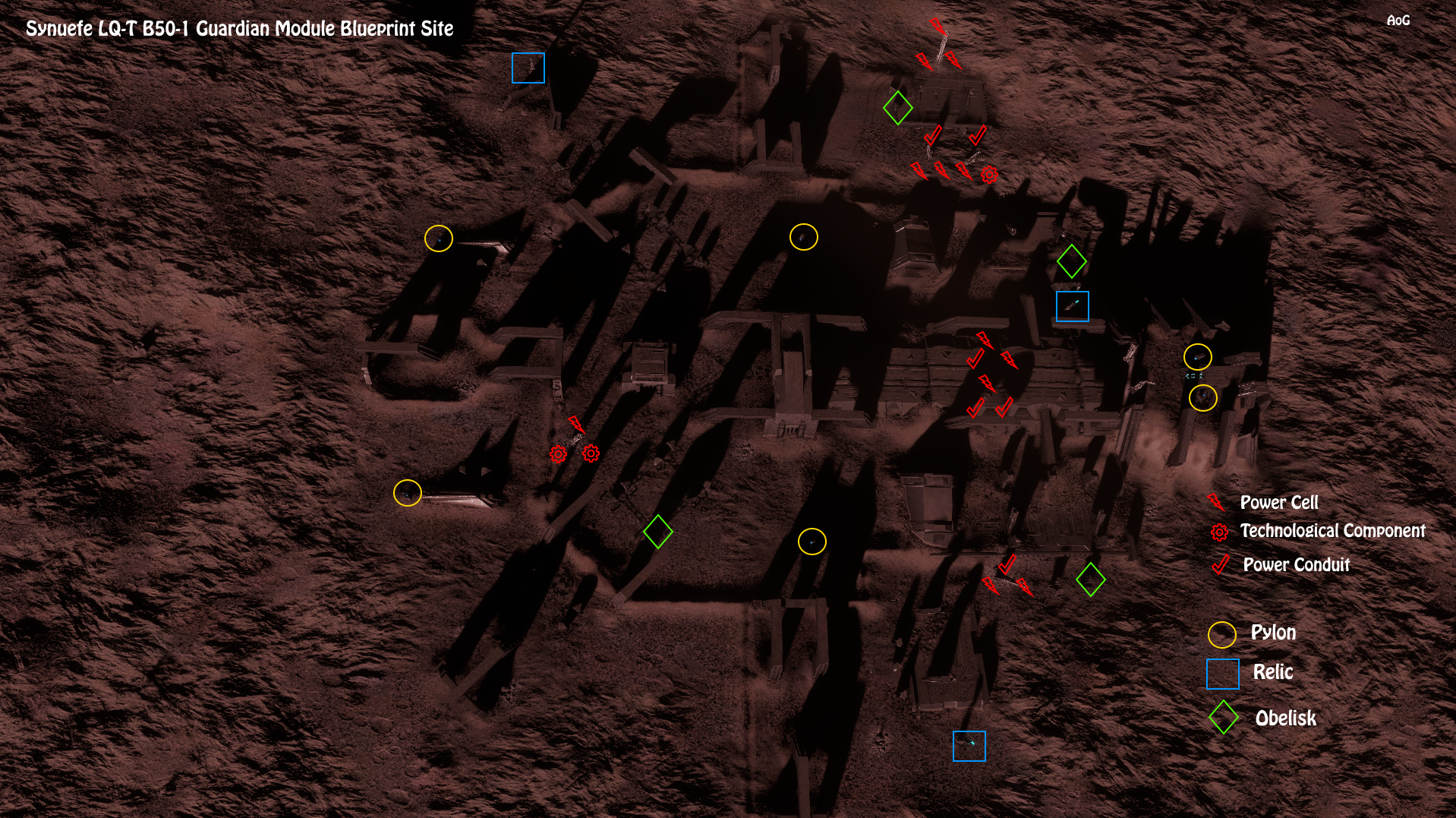
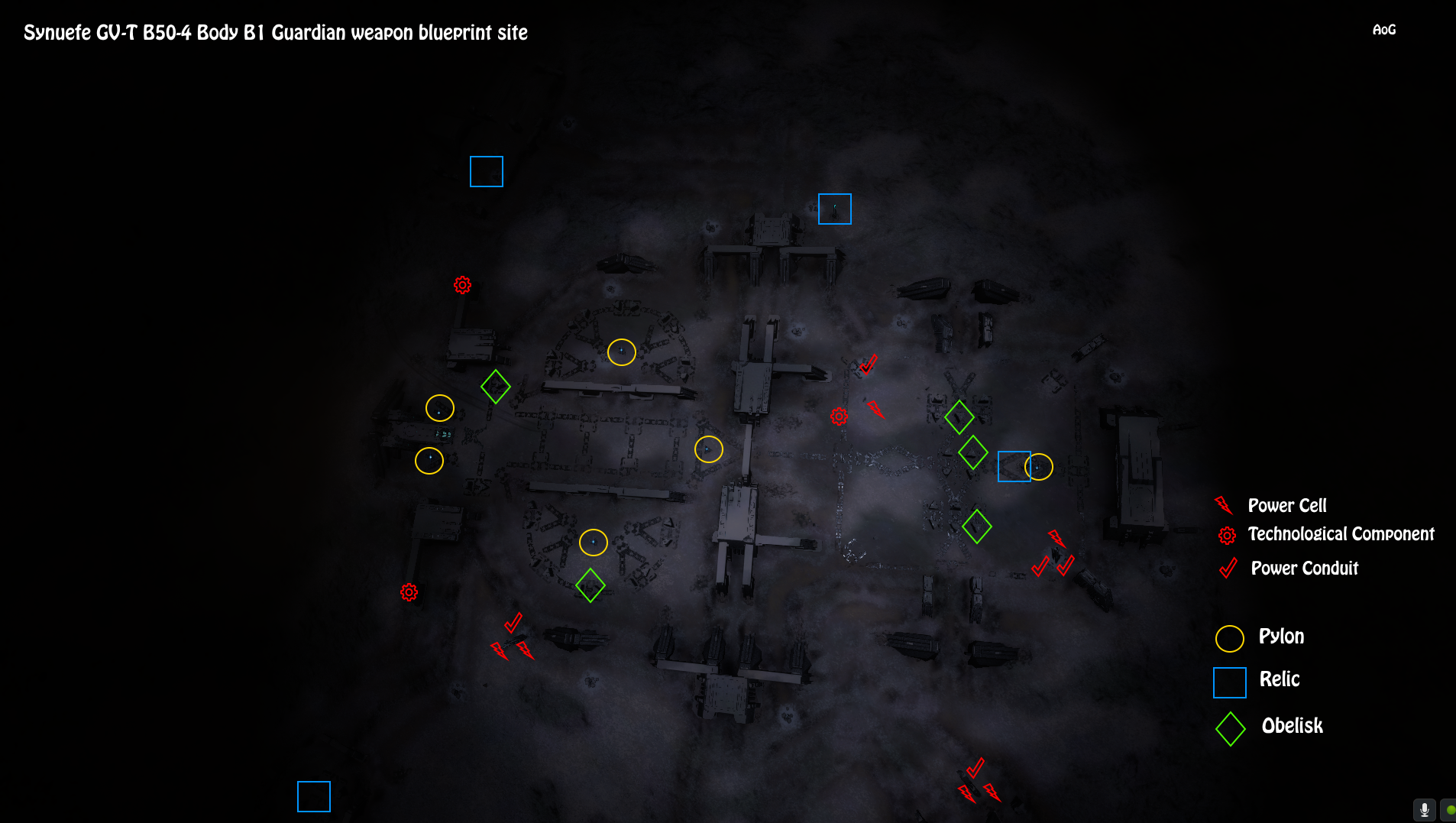
¶ Materials
Guardian materials can be found at various active guardian sites. Some drop from destructible panels, and some drop from destroyed sentinels. A list of where to find each material can be found here.
¶ Guardian Technology Components
Guardian Technology Components (GTCs) are infrequently-found (if at all) at many Guardian sites and yet required by many weapons/modules. It might be more efficient for you to farm them separately from other Guardian materials by visiting Synuefe HT-F D12-29, planet C 3 as this site has eight separate spawns, so one run will fill up 24 GTCs.
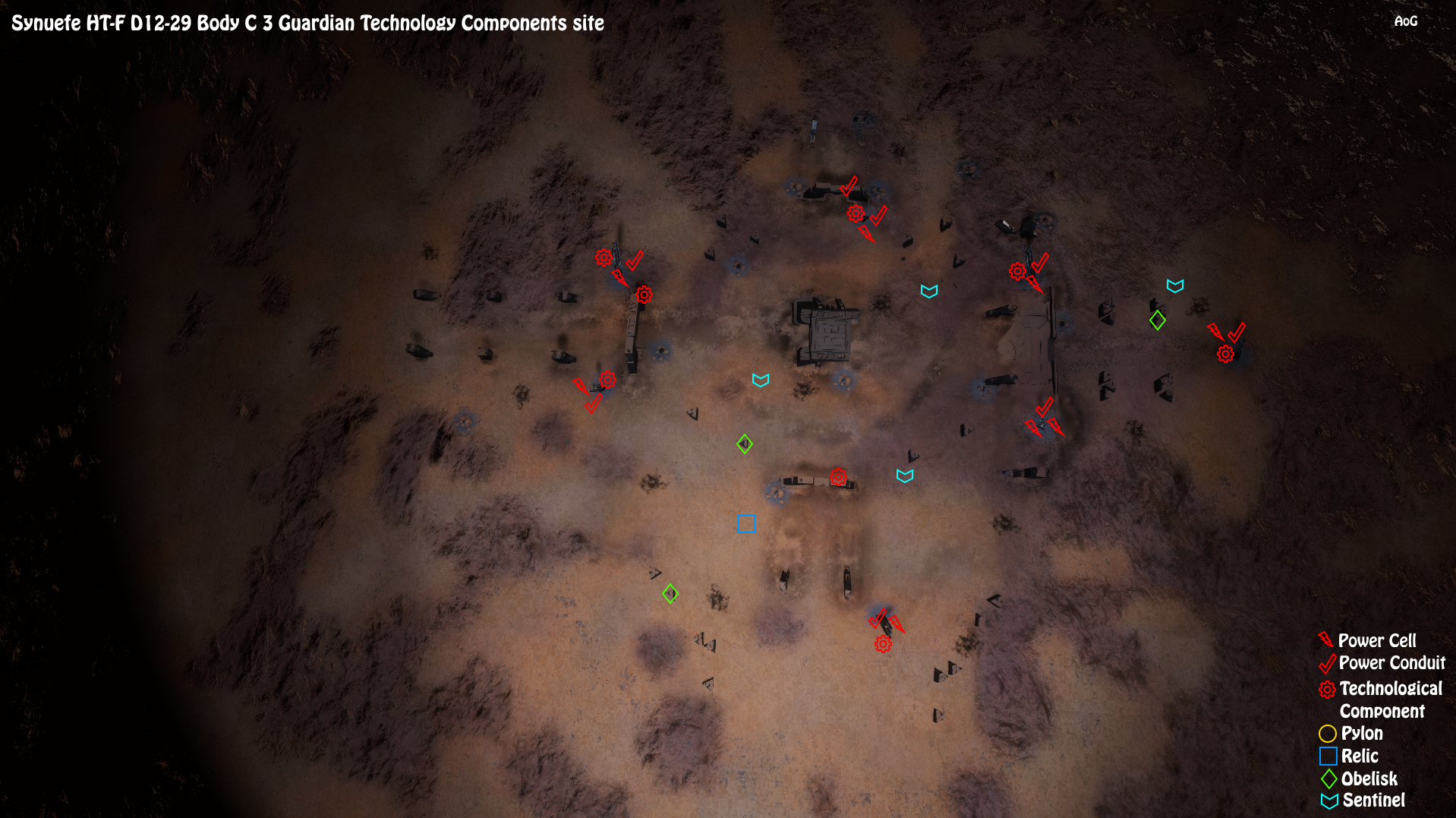
¶ Data
Guardian Pattern Data comes in various forms, and can be obtained from scanning any active obelisk. Drops are random, and many relogs are required to get the data you need. While any guardian site has active obelisks, we recommend Synuefe XR-H D11-102, planet 1 B for pattern data, as there is a site with 4 obelisks next to each other.
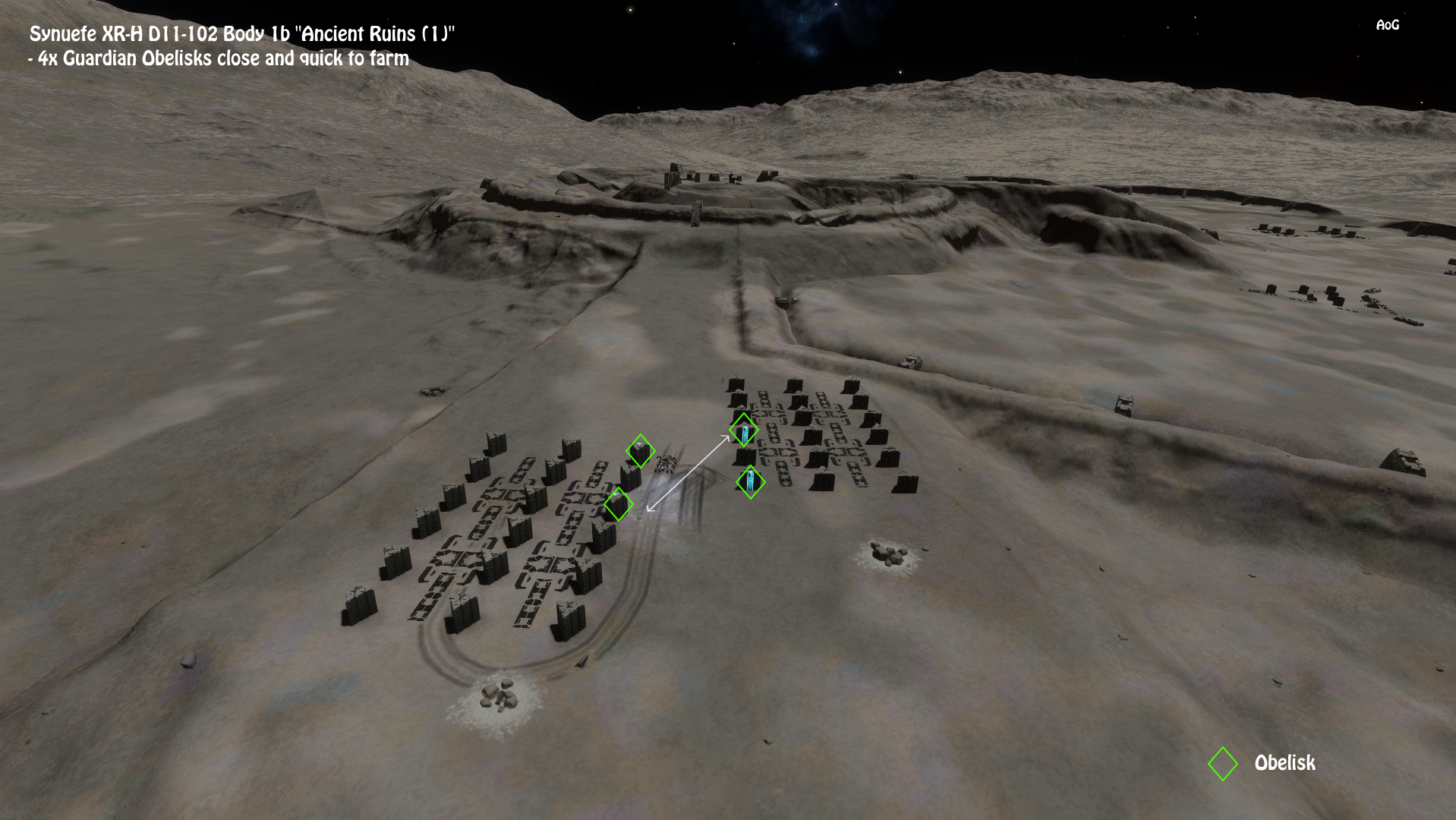
¶ Thargoid Materials
¶ Sensor Fragments
Guide by CMDR FlyBoyXD of the FRC and CMDR Vorsipellis
Required to unlock the Engineer Professor Palin, sensor fragments can be gathered by destroying Thargoid Scavengers, or the scoopable objects Thargoid Links and Thargoid Sensors. You can find Thargoid Sensor fragments very close to Professor Palins lab at a crashed ship at the following location.
System: Solati
Body: Halla
Coordinates: 36.9423, -100.2683
Stuff: 1 Thargoid Sensor, 1 Cargo Rack which drops one of the following (V, Cr, Zr, Zn, Mn, Sb), Ship Data Core.
- Land and drive up to the crash site in your SRV. You should find a Thargoid Sensor object flashing and beeping near the back of the wreck.
- Shoot it until it explodes into several scoopable Sensor Fragment materials.
- Pick them up with your SRV cargo scoop.
- Relog to cause it to respawn and repeat again.
This is the closest system to Arque (Palin) to get Sensor Fragments at less than 28 LYs distance. Destroy the Sensor to gather the fragments. You can relog at this site to spawn another.
Alternatively, you can visit a Thargoid structure (where we cook Guardian Relics) and hunt Thargoid Scavengers and Thargoid Links/Sensors.
¶ Titan Drive Components
Guide by CMDR Vorsipellis
Titan Drive Components (TDCs) are a required commodity for the Pre-Engineered FSD SCOs that were awarded (and made available through Human Tech Brokers) after Titan Cocijo’s death. The only place that they can be found are at Titan graveyards.
As a note, there is currently no known shortcut to collecting Titan Drive Components besides elbow grease and RNG - they are incredibly rare spawns. We recommend a fast ship with A-rated sensors (long range engineered if possible, but not necessary), collector limpets, and Anti-Corrosion Cargo Racks. Fly around the whole area of any Titan’s wreck and keep checking your contacts panel and pray to RNGesus. They are not limited to spawning near the big pieces of the wreck, and can sometimes spawn at the edge of the cloud too.
Some things that have empirically (but are not confirmed) to improve your chances:
- Relog (from desktop) and try again if you’ve covered the whole area.
- More players may increase spawns, although that also increases competition - bringing a friend you trust or an alt account might help.
- There seems to be some maximum limit on how many scoopable items can spawn in an area before new ones will spawn. Try picking up some materials or commodities as this has been seen to cause TDCs and other scoopables to spawn out of thin air.
- Praying harder to RNGesus.
¶ Propulsion Elements, Weapon Parts, Wreckage Components, Bio-Mechanical Conduits
Guide by CMDR Vorsipellis
Propulsion Elements are another requirement of the Pre-Engineered FSD SCOs, while Weapon Parts, Wreckage Components, and Bio-Mechanical Conduits are a requirement for Pre-Engineered Azimuth EAXMCs. These can be found as scoopables in Titan graveyards, or alternatively by farming Thargoid Scouts in NHSS Threat 4’s and NHSS Threat 5’s. The NHSS Guide provides information on how to find them.
¶ Material Trading
If you are not able to obtain the raw, manufactured, or encoded materials you need directly (usually lower-grade materials), it is sometimes possible to trade other materials of the same type at a material trader for a cost. Different material traders will handle different material types such as Data, Raw and Manufactured.
You can find the nearest trader with Inara’s station search.
When trading you will always lose some value. You will lose even more if you trade across different categories.
Ideally you want to gather materials at the highest grade possible and trade downwards.
¶ Other Useful Links
- Ship Build Theory page - Information on how to engineer your ship
- Elite Materials - Comprehensive summary of material sources
- ED Discovery - Aids with planetary navigation, among many other useful features.
- Weapon Unlock Costs - Inara keeps a list of tech broker unlock requirements.
¶ Contributors
- Airom
- Jetlagged
- Kriskara
- MGram
- SecretPro
- Toscany
- Vorsipellis